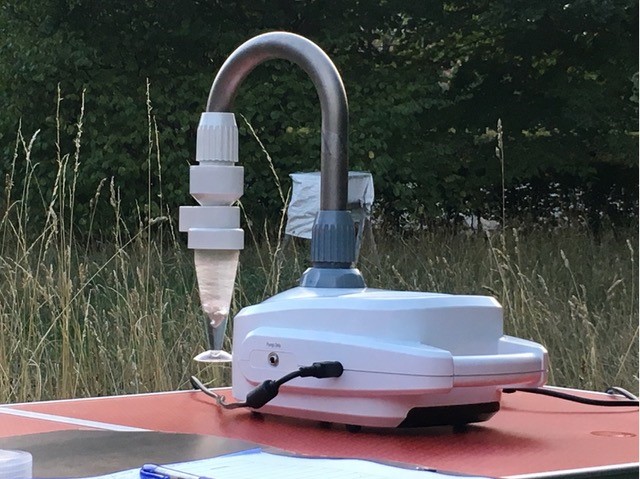Something in the air

Tom Ireland speaks to ecologist Dr Fabian Roger about using airborne DNA to detect species living nearby
Dr Fabian Roger is an ecologist and postdoctoral researcher interested in new methods to discover and monitor biodiversity. In recent work, he and his colleagues at Lund University in Sweden discovered for the first time that it is possible to detect insect DNA in samples of air[1]. Roger’s work follows similar studies that show airborne DNA can be used to discover communities of vertebrate, plant and microbial species too[2,3].
The study of environmental DNA (eDNA) in the air is in its infancy compared with the study of aquatic eDNA, which has been used for some years to monitor biodiversity and detect the presence of rare or protected organisms in bodies of water. However, Roger’s initial proof-of-concept study, which detected more than 70 species of insect as well as many mammals and birds, has strengthened the idea that terrestrial biodiversity could be monitored quickly, cheaply and non-invasively from the air.
If existing methods can be refined and airborne eDNA better understood, it would enable scientists to scale up and speed up biodiversity surveys, or detect the presence of invasive species and disease vectors over a large area, just using air samples. Ahead of the presentation of his work at the Ecology Across Borders conference, Roger spoke to The Biologist about the exciting applications of this technology and why further research is needed to understand how, when and where DNA is shed into the air.
Dr Roger, let’s start with the basics – what is environmental DNA?
Environmental DNA, or eDNA, is extra-organismal DNA – that is, DNA found in the environment that has been shed by organisms. The great thing with extra-organismal DNA is that it enables you to detect an organism without actually seeing that organism or without needing to capture it. In aquatic ecosystems you have this aqueous matrix in which things become very well mixed. You can go into a lake and take a few litres of water and find the majority of, say, its fish species without necessarily even being close to any individuals.
In a terrestrial ecosystem eDNA sampling has traditionally been limited by the local scale of the samples. You could study pollinator flower interactions, or the grazing of leaves by ungulates, or you could get a very local sample by rolling the bark of a tree or taking a topsoil sample. Generally, it is really difficult to get good integrated samples of extra-organismal DNA in terrestrial ecosystems.
Using air from three sites in Sweden, you were able to detect and identify 75 species of insect from 12 orders – including Diptera (flies), Lepidoptera (butterflies and moths), Coleoptera (beetles) and Hymenoptera (bees, wasps and ants). What are the best ideas about how this organismal DNA is finding its way into the sky and staying there? Are there wing cells coming off insects that are flying around or is it free-floating DNA?
Insect scales have been found in microscopy studies to make up quite a sizable fraction of aerosols. But the honest answer is we don’t know. I guess it’s all of the above. If you look at studies that have tried to characterise or think about what state eDNA comes in, it can be really small chunks of dandruff-like cell aggregates, but you can also find single cells, and if single cells break down you might have free cells, organelles, mitochondria. If they break down, you might have free DNA and this DNA might be bound to particles or not.
All the states that eDNA comes in are pretty small. They are below 100 micrometres – most below 10 micrometres – and particles of this size have a tendency to get and stay airborne. I think what we find is a mixture of things that have been released directly into the air, dirt flying around might contain DNA, and things might have been suspended or resuspended by the wind.
 Airborne eDNA has now been used to detect the presence of nearby insects, plants and mammals.
Airborne eDNA has now been used to detect the presence of nearby insects, plants and mammals. Presumably there’ll be a bias towards airborne species, and there may be a bias within those species towards those more likely to shed cells or DNA?
Yes, we should assume so. Also, if you look at insects under the microscope, some are just much hairier, so you could even imagine that those might lose more eDNA particles or fragments than others. If what you are asking is whether that would be an inherent problem for this method, what I would say is that we haven’t found a sampling method yet that is bias free. If you do sound recordings, they could be biased towards species that vocalise at that time of the year; and if you do visual surveying, you can only identify species that are very conspicuous, etcetera. For many species we really don’t have good surveying methods.
Would you be able to paint a picture for our readers of how you go about sampling air?
We’re in a nice situation in that we don’t need to figure out how to sample air – aerosol science is an established research field and does exactly this already. You can sample particles from the air and there’s an exciting variety of ways to do it. One way we did it was to have a sampler that is shaped like a swan head and a cone beneath that swirls the air into liquid. The particles get pushed into the liquid, from where we can filter them and analyse them.
We have also used a commercial vacuum cleaner that is water based and hypoallergenic, because again it keeps all the particles in the water and has a high flow rate of air. Then there are other methods where the particles are trapped in filters. I think it’s going to be interesting to compare different methods and see which is most suited to getting the particles we want for our purposes.
Can you draw any conclusions about abundance from airborne eDNA?
To be clear, this study is just a proof of concept that we could find airborne DNA. But your question is one that is always addressed in eDNA work, and rightly so. Like in aquatic ecosystems, in general we see that the samples or the species that make up the most reads tend to be the species that are most abundant. This is unless there are special circumstances – for example, if you have a species that is breeding at that time or has some other behaviour that makes its DNA more present in the environment.
It’s easier to compare relative abundance of one species across sites than to compare the abundance of different species at the same site, because the biases will be constant. So it’s easier to say ‘we have more of the species here than here’ rather than ‘we have more of that species than of that species’. Then you can look at prevalence: how often do we find a species? Do we find it every time in every sample? If so, it’s probably an abundant species. If the detection is stochastic, and you find it in one out of 10 samples, you can then take it that it is probably a less-abundant species. You also have the distinction between metabarcoding, when you look at a lot of species at the same time, and single-species detection, where it can be more sensitive.
 The hoover-like apparatus used to take in and remove particles from air from the environment.
The hoover-like apparatus used to take in and remove particles from air from the environment. What about airborne particles that have travelled long distances, perhaps from beyond the area you want to sample?
While it might well be that DNA from sources that are far away is captured, my gut feeling – and it’s not much more than that – is that the DNA locally is dominated by local sources. If you have a source that emits a lot of DNA, and that source is not present elsewhere, you would assume it dilutes very quickly.
Do you expect this to become a more mainstream method of terrestrial biodiversity sampling?
I do expect that now that the word is out people will go and try it out for their study organism or try it out for their system and see what they get. How sustainable it will be will depend on the success we have in getting good results. If we all end up finding that it’s too stochastic to really provide useful information, then that might be the end of it.
But people are using it for pollen or fungal spore sampling quite successfully. Mark D Johnson in Mark Barnes’ group showed pollen sampling with passive samplers can give you a really good overview of the plant community in an area, or that eDNA sampling can detect small leaf fragments or other parts of the plant that get aerosolised. There is the work of Kristine Bohmann and her postdoc, Christina Lynggaard, who did a zoo study in Copenhagen showing that it works for vertebrates. So I think that evidence will start to pile up that there might be something to it. And, if that gets confirmed, I do expect that research interest will be big.
What’s really exciting is the scale that would be possible – I mean, you could fly a plane across a very large environment with this equipment and suddenly you have a sampling area that’s wildly bigger than you could ever have dreamed of collecting from with more conventional sampling methods.
I think that’s where the big strengths and big excitement for this method lie, yes. Obviously, we’re not here to replace traditional sampling – we need the natural history knowledge and will always need the taxonomic expertise. However, on the other hand we can complement that by taking samples easily and cheaply on large geographic scales. And that would potentially allow for a much denser network of biodiversity monitoring stations than we have today and enable us to survey the natural world in completely different detail.
In our preprint we lay out the potential future uses we see, and of course imagination sets the limit. If these methods turn out to be very sensitive and we manage to get reliable detection, we can apply this in any case where we want to have knowledge of the presence of a species.
2) Lynggaard, C. et al. Airborne environmental DNA for terrestrial vertebrate community monitoring. Curr Biol. Epub ahead of print (2022). PMID: 34995490.
3) Johnson, M. D. et al. Airborne environmental DNA metabarcoding detects more diversity, with less sampling effort, than a traditional plant community survey. BMC Ecol. Evol. 21, 218 (2021)
Dr Fabian Roger is a postdoc working in the Department of Environmental Systems Science, ETH Zurich University, Switzerland.


